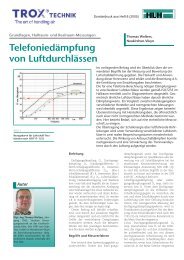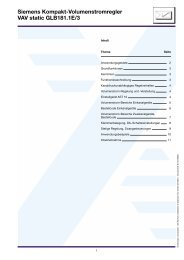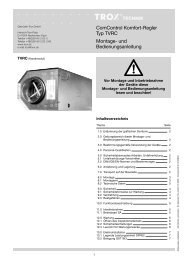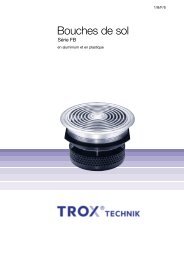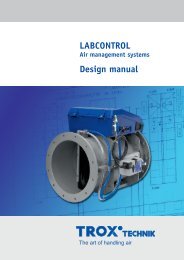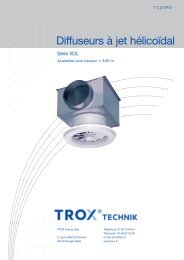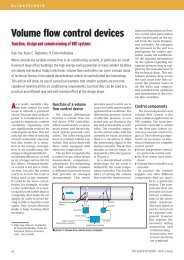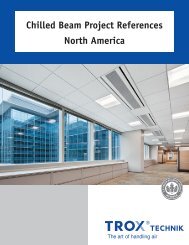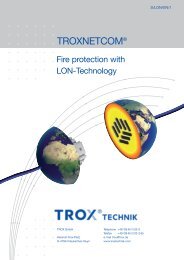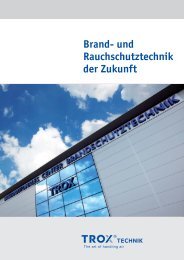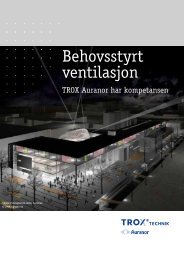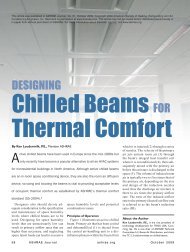Create successful ePaper yourself
Turn your PDF publications into a flip-book with our unique Google optimized e-Paper software.
Control Strategies<br />
CHILLED BEAM CONTROL CONSIDERATIONS<br />
This section discusses the control of both the air and<br />
the water supply in chilled beam systems. It also<br />
presents and discusses strategies for condensation<br />
prevention.<br />
Temperature control and zoning with chilled beams<br />
Room temperature control is primarily accomplished by<br />
varying the water flow rate or its supply temperature to<br />
the chilled beam coils in response to a zone thermostat<br />
signal. Modulation of the chilled water flow rate typically<br />
produces a 7 to 8˚F swing in the beam‟s supply air<br />
temperature, which affects a 50 - 60% turndown in the<br />
beam‟s sensible cooling rate. This is usually sufficient<br />
for the control of interior spaces (except conference<br />
areas) where sensible loads do not tend to vary<br />
significantly. If additional reduction of the space cooling<br />
is required, the primary air supply to the beam can be<br />
reduced. In any case, modulation of the chilled water<br />
flow rate or temperature should be the primary means<br />
for controlling room temperature as it has little or no<br />
effect on space ventilation and/or dehumidification. Only<br />
after the chilled water flow has been discontinued<br />
should the primary airflow rate be reduced.<br />
Thermal control zones for chilled beam applications<br />
should be establish in precisely the same manner they<br />
are defined for all air systems. These zones should<br />
consist of adjacent spaces whose sensible cooling<br />
requirements are similar, and several beams should be<br />
controlled from a single space thermostat. For example,<br />
the beams serving several perimeter spaces with the<br />
same solar exposure can be controlled by a single<br />
thermostat to create a zone of similar size to that which<br />
might be served by a single fan terminal in an all air<br />
system. Conference rooms and other areas with widely<br />
varying occupancy should be controlled separately.<br />
Control of the primary airflow rate<br />
Figure 22 illustrates a <strong>TROX</strong> model VFL flow limiter<br />
which can be fitted directly to the inlet side of the active<br />
beam. This limiter is fully self-contained and requires no<br />
power or control connections. It may be field set to<br />
maintain a volume flow rate to the beam. VFL limiters<br />
are recommended for use on beams fed by the same<br />
air handling unit supplying VAV terminals. The VFL<br />
compensates for system pressure changes to maintain<br />
the beam‟s design airflow rate.<br />
VFL flow limiters require a minimum of 0.15 inches H 2 O<br />
differential static pressure to operate. This must be added<br />
to the catalogued pressure loss of the beam to arrive<br />
at an appropriate inlet static pressure requirement. For<br />
acoustical reasons, the inlet static pressure should not<br />
exceed 1.0 inches H 2 O. More information on VFL flow<br />
limiters may be found in <strong>TROX</strong> leaflet 5/9.2/EN/3.<br />
Figure 22: <strong>TROX</strong> VFL Flow Controller<br />
The most economical way to control the output of the<br />
chilled beam is to modulate the water flow rate through<br />
the coil. This may be accomplished in either of two<br />
ways. Figure 23 illustrates a typical piping and hydronic<br />
control schematic for a single thermal zone utilizing<br />
chilled beams. There are isolation valves within each<br />
zone which allow the chilled beam coils within the zone<br />
to be isolated from the chilled water system. This<br />
enables beams to be relocated or removed without<br />
disturbing the water flow in other zones. The coils‟ water<br />
flow rate is throttled by a 2-way chilled water valve<br />
actuated by the zone thermostat. Most chilled beam<br />
systems utilize floating point valve actuators that<br />
provide on-off control of the beam water flow. Throttling<br />
the water flow rate results in variable volume flow<br />
through the main water loop while its supply and return<br />
water temperatures tend to remain relatively constant.<br />
Figure 24 shows a zone within a chilled beam system<br />
that is controlled by a 3-way valve. Such a schematic<br />
will allow modulation of the chilled water flow to the<br />
beams within the zone while maintaining a constant<br />
volume flow rate within the main distribution system.<br />
Such control may be advantageous in cases where a<br />
dedicated chiller is used and significant variations in the<br />
water flow rate can result in danger of freezing within<br />
the chiller itself. Three way valves are also frequently<br />
used when condensation prevention controls are<br />
employed.<br />
The piping illustrated in figure 23 is reverse-return. The<br />
first unit supplied with chilled water is the farthest from<br />
the main chilled water return. Using reverse-return piping<br />
tends to adequately balance the water flow to multiple<br />
beams within a single zone.<br />
<strong>Chilled</strong> (and hot) water flow control strategies<br />
21





